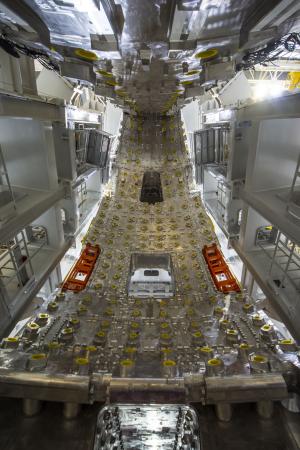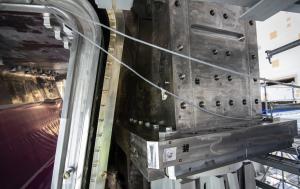Aligning building-size components with millimetric precision
Final alignment has been achieved for the first building block of the ITER plasma chamber—four major components, totalling 1,250 tonnes, have been aligned to within 1 mm of tolerance in the radial, toroidal and vertical directions. This major achievement smooths the way for the similar assembly of eight other sub-assemblies in the months and years ahead.
A "sub-assembly" brings together a 40-degree, 440-tonne sector of the ITER vacuum vessel, the sector's thermal shield, and two 18-metre-tall, 360-tonne D-shaped toroidal coils. Nine sub-assemblies are required to form the full torus of the plasma chamber.
The first step in this first-of-a-kind assembly sequence was taken in April 2021 when vacuum vessel sector #6 was installed inside one of the twin sub-assembly tools, soon to be followed by thermal shield panels and toroidal field coils TF12 and TF13.
Precision in assembling and positioning these mammoth components is paramount; any deviation from required tolerances in any component would result in knock-on issues in the sub-assembly and the finalized torus.
"It all begins at the design phase with 3D model simulations," explains Chang Ho Choi, the head of the ITER Sector Modules Delivery & Assembly Division. "Computer models, however, belong to the ideal world of perfection. Industrial reality, especially for components as tall as a six-storey building, is inevitably different. The components' conformity is verified and qualified throughout the fabrication process, and all the way to factory and site acceptance tests. By then we have the "as built" data, which reflects the actual dimensions of the component."
Some deviations unavoidably occur during the manufacturing process. "The question is: how will these deviations impact the assembly phases? And if they do, how can they be mitigated or corrected?" Local machining, the welding of shims, and interface adaptations are among the available solutions.
Components are not the only ones concerned by minute deviations, however. During the first sector sub-assembly activities the assembly tool, despite its size and sturdiness, had bent slightly (one millimetre of displacement at the top) under the combined weight of the components (1,250 tonnes).
"The bending was anticipated," says Chang Ho. "But still, it impacted the alignment of the structures that structurally link the two coils (outer intercoil structures) when they are in their final position."
The issue is being solved two ways. One is by making the best of the "adjustability and incredible precision"* of the sub-assembly tool; the other is by slightly offsetting the axis of the steel dowels inside the sleeves that connect the intercoil structures to the coils.
Once these operations are complete, temporary bracing tools will be installed between the vacuum vessel sector and the toroidal field coils in order to maintain the proper distance of a few centimetres between them. The first of the nine pre-assemblies should be ready for lifting in the second half of November—a delicate, most strategic and assuredly most spectacular operation.
* A set of hydraulic devices and "hilman rollers" provides the sector sub-assembly tools with six degrees of freedom (x, y, z, and radial, toroidal and vertical rotation).




